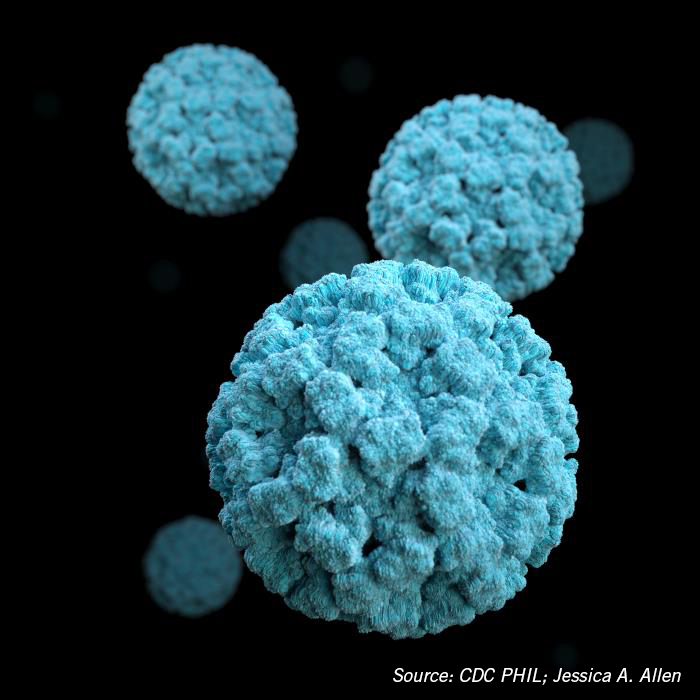 The average soccer ball is about 1.6 million times bigger than a grain of sand. A grain of sand is about a million times bigger than a single bacterial cell, and a single bacterial cell can be 40 to 100 times bigger than a norovirus particle.
The average soccer ball is about 1.6 million times bigger than a grain of sand. A grain of sand is about a million times bigger than a single bacterial cell, and a single bacterial cell can be 40 to 100 times bigger than a norovirus particle.
It is astonishing that norovirus, something so small in comparison to the human body, can wreak such havoc.
According to the CDC, the most common cause of foodborne illness outbreaks is norovirus. While it takes only 10-100 norovirus particles to cause an infection, it is estimated that a person may expel as many as 30 million norovirus particles during one vomiting episode. In addition, these particles are also present in the millions in the infected person’s fecal matter.
To make matters worse, it is reported that the norovirus can survive on objects and surfaces such as toilets, toilet “flush” levers, faucets, door handles, computer keyboards, countertops, and telephones for days, weeks, and in some cases even longer.
 How does it spread?
How does it spread?
Over the course of an illness, a person can shed billions of norovirus particles, either through their vomitus or in their stool. Because the norovirus particles are so tiny, they can aerosolize. This means when a toilet is flushed, or the infected person vomits, the particles can be sprayed into the air. These particles then settle on any nearby surfaces, lying in wait for their next victim.
Norovirus particles can be found in vomit or stool several days before the infected person starts feeling ill, and they can be present for up to two weeks after symptoms are gone. It is no wonder that norovirus is notorious for quickly spreading through enclosed spaces, such as daycare centers, nursing homes, college dormitories, and cruise ships.
 What are the symptoms?
What are the symptoms?
The norovirus causes the stomach and intestines to become inflamed (also known as acute gastroenteritis). Diarrhea, vomiting, nausea, and stomach pain are common symptoms along with fever, headache and body aches.
A person usually develops symptoms 12 to 48 hours after being exposed to norovirus. They may feel extremely ill, and may vomit or have diarrheal episodes many times a day. The good news is that most people will get better in 1-3 days.
Yuck! What can I do?
 The most important thing you can do is wash your hands carefully with soap and water especially after using the toilet and changing diapers, and always before eating, preparing, or handling food. You can use alcohol-based hand sanitizers, but they should not become a substitute for soap and water.
The most important thing you can do is wash your hands carefully with soap and water especially after using the toilet and changing diapers, and always before eating, preparing, or handling food. You can use alcohol-based hand sanitizers, but they should not become a substitute for soap and water.- Clean and disinfect contaminated surfaces. Remember the aerosol? Studies have shown that not all disinfectants are effective against norovirus. However, one disinfectant that is effective is a chlorine bleach solution with a concentration of 1000–5000 ppm which translates to approximately 5–25 tablespoons of household bleach per gallon of water.
 Because fruits and vegetables can be contaminated right from the grocery store, they should be washed thoroughly. In addition, be aware that ready-to-eat foods can be contaminated by infected food preparation workers or by insufficient food safety practices at your favorite delicatessen or restaurant.
Because fruits and vegetables can be contaminated right from the grocery store, they should be washed thoroughly. In addition, be aware that ready-to-eat foods can be contaminated by infected food preparation workers or by insufficient food safety practices at your favorite delicatessen or restaurant.- When you are sick, do not prepare food for or care for others who are sick.
- Finally, to avoid infecting others, immediately and thoroughly wash clothes and linens that are (or may be) contaminated with vomit or feces.
Learn more about norovirus by taking part in National Food Safety Month. Use #NFSM and #NotoriousVirus to follow the conversation.
Resources





0 Comments